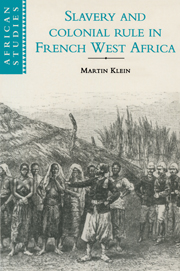Book contents
- Frontmatter
- Contents
- List of illustrations
- List of maps
- List of tables
- Preface
- List of abbreviations
- Glossary
- 1 Slavery in the Western Sudan
- 2 Abolition and retreat. Senegal 1848–1876
- 3 Slavery, slave-trading and social revolution
- 4 Senegal after Brière
- 5 Conquest of the Sudan: Desbordes to Archinard
- 6 Senegal in the 1890s
- 7 The end of the conquest
- 8 The imposition of metropolitan priorities on slavery
- 9 With smoke and mirrors: slavery and the conquest of Guinea
- 10 The Banamba Exodus
- 11 French fears and the limits to an emancipation policy
- 12 Looking for the tracks. How they did it
- 13 After the War: renegotiating social relations
- 14 A question of honor
- Appendixes
- Notes
- Bibliography
- Index
- Titles in the series
3 - Slavery, slave-trading and social revolution
Published online by Cambridge University Press: 07 May 2010
- Frontmatter
- Contents
- List of illustrations
- List of maps
- List of tables
- Preface
- List of abbreviations
- Glossary
- 1 Slavery in the Western Sudan
- 2 Abolition and retreat. Senegal 1848–1876
- 3 Slavery, slave-trading and social revolution
- 4 Senegal after Brière
- 5 Conquest of the Sudan: Desbordes to Archinard
- 6 Senegal in the 1890s
- 7 The end of the conquest
- 8 The imposition of metropolitan priorities on slavery
- 9 With smoke and mirrors: slavery and the conquest of Guinea
- 10 The Banamba Exodus
- 11 French fears and the limits to an emancipation policy
- 12 Looking for the tracks. How they did it
- 13 After the War: renegotiating social relations
- 14 A question of honor
- Appendixes
- Notes
- Bibliography
- Index
- Titles in the series
Summary
… though the jihad was well nourished by a sincere religious passion, the desire to propagate the faith transformed itself into a more profane design: the effort to proselytize died out almost as soon as it was proclaimed, quickly, the distinction between Muslims and pagans came to justify the production of slaves for the domestic market and of captives for the international market.
Roger BotteEndemic warfare had become so common in northern Dafina that people could no longer visit their ancestral shrines. Instead, each village developed its own religious custodians, who were usually from the grave-digger's caste, and each village looked to itself for protection.
Myron EchenbergThe second half of the nineteenth century was a turbulent period throughout the area I have studied, a period of violent struggle, of transformations never completed, of dramatic changes annulled because the whole area eventually fell under the control of the French. It was a period of increasing trade and production for market, of state-builders who tried to capitalize on the potential for change, and of increasing Islamization. Three themes intertwine themselves through the period: Islamic revolution, the increasing production of commodities, and new tools for making war. All were related to and often distorted by the region's tragic dependence on slave labor. All three of these themes were present earlier: to understand the history of slavery in the modern period, we must examine earlier transformations.
- Type
- Chapter
- Information
- Slavery and Colonial Rule in French West Africa , pp. 37 - 58Publisher: Cambridge University PressPrint publication year: 1998
- 1
- Cited by

